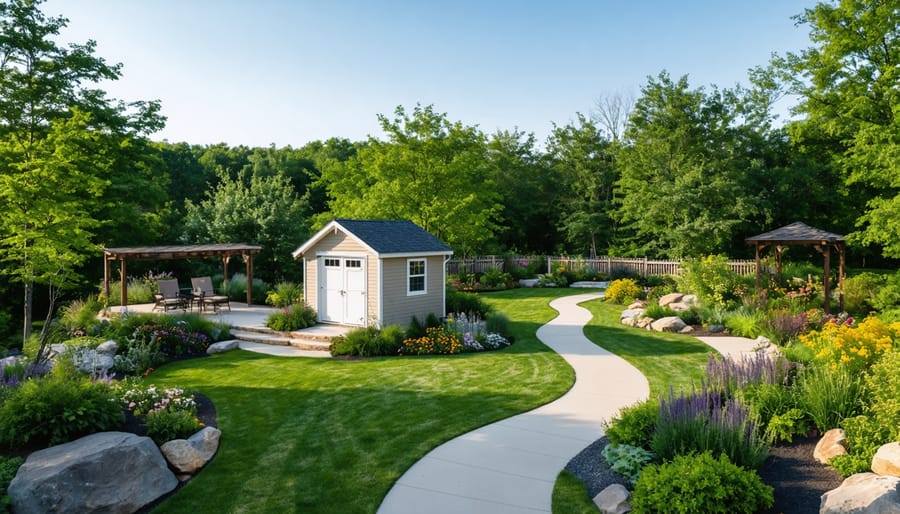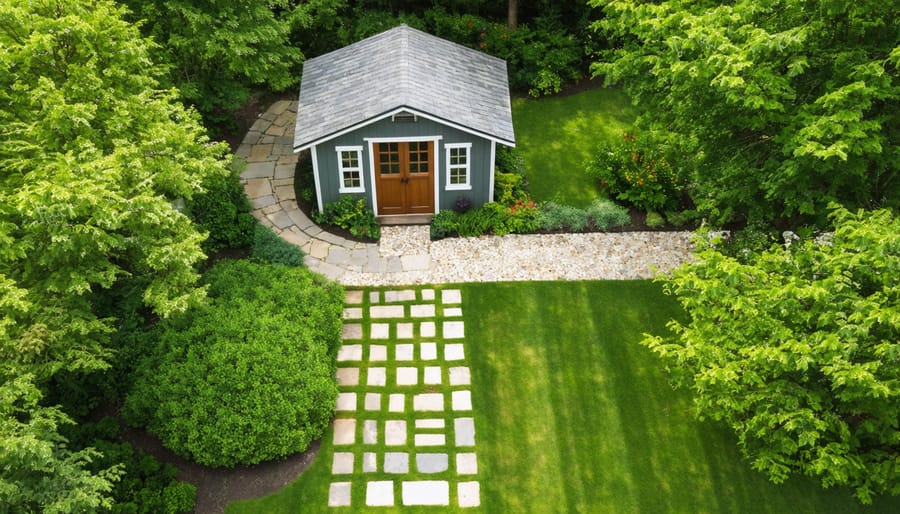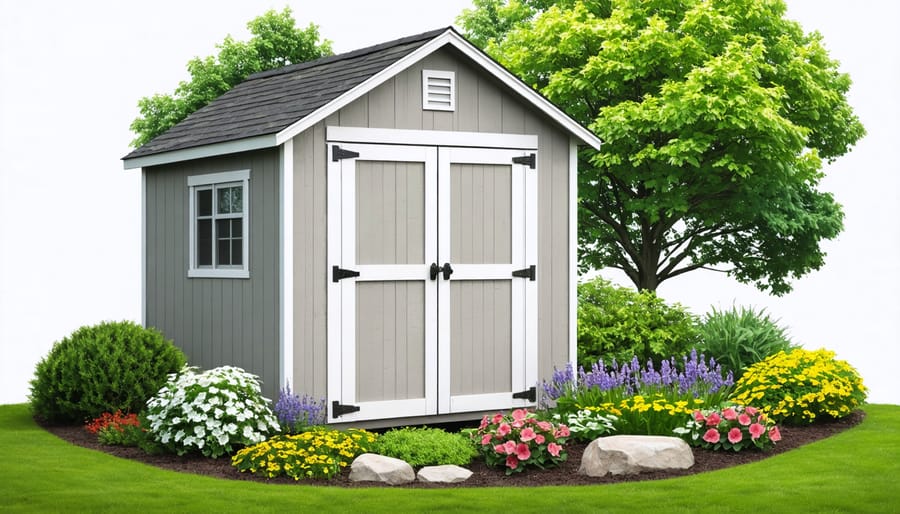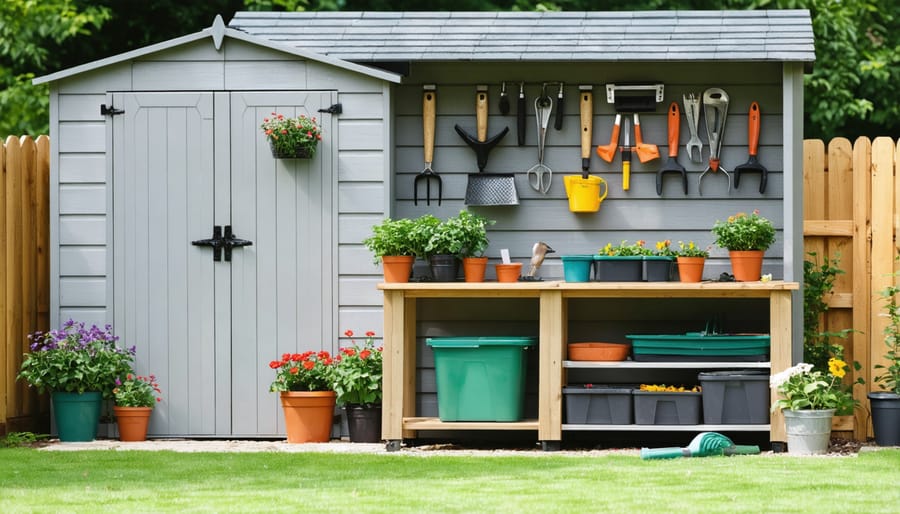Transform Your Acre: Beautiful Shed Integration That Enhances Your Property

Transform your acre of land into a stunning outdoor sanctuary by dividing it into distinct functional zones – a welcoming entertainment area near the house, tranquil garden rooms throughout the middle space, and a naturalistic woodland retreat in the back. Create sweeping curves and meandering pathways that guide visitors through your landscape, connecting each area while maintaining visual flow and reducing maintenance needs. Integrate multi-season interest with strategic placement of evergreen foundational plants, flowering perennials, and architectural elements like pergolas or water features that serve as focal points year-round.
Layer your plantings strategically, starting with tall trees for privacy and shade, medium-height flowering shrubs for structure, and ground covers for weed suppression and visual continuity. Consider how your property’s natural topography can enhance the design – terracing slopes for added interest, creating rain gardens in low areas, or establishing raised beds for vegetable gardens and cut flowers. Balance open spaces with densely planted areas to create rhythm and movement throughout your acre while maintaining practical considerations like sight lines from windows and easy access to utilities.
This thoughtful approach maximizes your property’s potential while creating manageable maintenance zones that can be developed over time as budget and resources allow.
Creating Natural Flow with Strategic Shed Placement
Utilizing Natural Sight Lines
When positioning your storage shed, working with your property’s natural sight lines can help transform your storage shed from a simple utility building into a captivating focal point. Start by identifying existing landscape features like mature trees, flower beds, or walking paths that naturally draw the eye. Place your shed where these elements converge to create a harmonious flow throughout your property.
Consider positioning your shed where it frames a beautiful view or serves as a backdrop for your garden. Natural slopes and elevation changes can work to your advantage – tucking the shed into a gentle hillside can make it appear more integrated with the landscape. If you have a long driveway or main walking path, angle the shed so it’s visible but not overwhelming when approaching your home.
Remember to account for both morning and afternoon sun patterns. This not only affects the shed’s appearance throughout the day but also impacts the growth of surrounding plants and the comfort level when using the structure. By thoughtfully aligning your shed with these natural elements, you’ll create a more cohesive and visually appealing landscape design.

Distance Planning and Accessibility
When planning your shed’s location on your one-acre property, consider both convenience and functionality. The ideal distance from your home typically ranges between 20 to 50 feet, allowing easy access while maintaining your yard’s visual flow. Position your shed where it’s readily accessible from both your house and the areas you’ll be servicing, such as gardens or workshop spaces.
Create clear pathways that connect your shed to high-traffic areas, ensuring you can easily transport equipment and supplies. For garden tools and materials, position the shed within comfortable walking distance of your planting areas. If you’re storing lawn equipment, central placement can minimize travel time when maintaining different sections of your property.
Consider seasonal accessibility as well. Ensure your chosen location stays dry year-round and isn’t in a low-lying area where water collects. Plan for adequate drainage around the structure and include a stable, level pathway that remains accessible in all weather conditions. Remember to account for any existing trees or landscaping features that might affect access routes or create maintenance challenges in the future.
Keep utility connections in mind if you plan to add electricity or water to your shed. Closer proximity to existing utility lines can significantly reduce installation costs while maintaining convenient access.
Seamless Integration Through Landscaping
Foundation Plantings
Transform your shed’s foundation into a stunning focal point with thoughtful plant selection and arrangement. Using proven shed landscaping techniques, create layers of visual interest that complement your structure while maintaining practical access.
Start with low-growing evergreens like boxwood or juniper along the front corners, providing year-round structure and color. Add medium-height flowering shrubs such as hydrangeas or butterfly bush along the sides to soften the shed’s lines and attract pollinators. For depth and texture, incorporate ornamental grasses like fountain grass or maiden grass in between larger plants.
Consider the shed’s exposure when selecting plants. Choose shade-tolerant varieties like hostas and ferns for north-facing areas, while drought-resistant plants like lavender and Russian sage work well in sunny spots. Leave adequate space between plants and the shed’s foundation for air circulation and maintenance access.
Add seasonal color with compact perennials like black-eyed susans or day lilies in the foreground. For a polished look, edge your foundation plantings with a neat border of river rocks or mulch, creating clear boundaries while suppressing weed growth and retaining moisture.

Creating Purposeful Pathways
Creating thoughtful pathways between your shed and other areas of your property enhances both functionality and visual appeal. Start by identifying primary traffic patterns – consider how you’ll move equipment from the shed to your garden, pool area, or workshop. Natural stone pathways offer a timeless look and excellent durability, while gravel paths provide a budget-friendly option that maintains good drainage.
For a cohesive design, incorporate curved pathways that follow your landscape’s natural contours. These flowing lines create visual interest and can lead visitors through garden features or around mature trees. Consider installing solar-powered path lights to ensure safe navigation after dark and add a warm ambiance to your evening landscape.
Wide paths (at least 4 feet) accommodate wheelbarrows and lawn equipment, while narrower secondary paths can branch off to create intimate garden walks. Enhance pathway edges with low-growing plants like creeping thyme or sedums, which add color and soften hard lines. For areas with steep grades, consider installing steps made from railway ties or stone slabs, incorporating handrails where necessary.
Remember to plan for drainage by slightly crowning pathways and installing proper base materials. This prevents water pooling and extends the path’s lifespan.
Screening and Privacy Solutions
Creating privacy on your one-acre property can be elegantly achieved through strategic landscaping choices. Fast-growing evergreen trees like Thuja Green Giants or Leyland Cypress make excellent natural screens when planted in rows, offering year-round coverage. For immediate privacy, consider installing wooden lattice panels with climbing vines like clematis or jasmine, which combine structure with natural beauty.
Layer your screening solutions by incorporating mixed heights of vegetation. Plant tall privacy trees at the back, medium-sized shrubs like viburnum or holly in the middle, and lower-growing plants in front. This creates a natural, flowing appearance while maximizing privacy. Strategic placement of ornamental grasses like pampas or maiden grass can provide subtle screening without feeling imposing.
For areas requiring quick solutions, bamboo planted in containers offers rapid growth and mobility. Consider incorporating decorative elements like pergolas or garden archways draped with flowering vines, which create private spaces while adding visual interest. Remember to maintain clear sightlines to your property’s entrance and ensure emergency access points remain unobstructed.
Multi-Purpose Landscaping Zones
Garden Work Station Design
A well-designed garden work station transforms your outdoor space into an efficient hub for all your landscaping activities. Create a dedicated area adjacent to your shed where you can organize your garden workspace and tackle projects with ease.
Start by installing a sturdy potting bench with a weather-resistant countertop. Position it where it receives partial shade during peak gardening hours, and ensure there’s enough space for essential tools within arm’s reach. Consider adding wall-mounted tool racks and shelving units to maximize vertical storage while keeping frequently used items accessible.
Include a water source nearby – whether it’s a spigot or a rain barrel system – to make plant care more convenient. Installing proper lighting enables extended working hours and improved visibility for detailed tasks. Motion-sensor lights are particularly useful for early morning or evening gardening sessions.
Don’t forget to incorporate comfort features like an anti-fatigue mat for standing and a small seating area for rest breaks. A retractable awning or pergola can provide necessary shade and weather protection while you work. For added functionality, include a soil storage bin and a dedicated space for storing pots and containers.
Make cleanup easier by adding a utility sink and establishing a designated area for composting nearby. This thoughtful organization will streamline your gardening routine and make maintaining your acre more enjoyable.

Recreational Area Integration
Transform your storage shed into a centerpiece of outdoor enjoyment by thoughtfully integrating it with recreational spaces. Create a charming transition zone by installing a pergola or arbor that connects your shed to a cozy seating area. This not only softens the shed’s appearance but also establishes a natural flow between storage and leisure spaces.
Consider positioning your shed near outdoor entertainment areas, using it as a convenient storage spot for garden games, outdoor furniture cushions, and barbecue equipment. Install hooks or shelving on the exterior walls to hang planters or display decorative items, making the shed both functional and visually appealing.
Design walking paths that naturally lead to and from your shed, incorporating them into your overall landscape plan. Use materials that complement your home’s architecture, such as stepping stones, gravel, or brick pavers. These pathways can double as borders for garden beds or recreational zones.
Make the most of the shed’s surroundings by creating multi-purpose spaces. Install a small deck or patio adjacent to the shed for a morning coffee spot or reading nook. Plant climbing vines or establish a butterfly garden nearby to enhance the aesthetic appeal while maintaining easy access to stored items.
For maximum functionality, consider adding outdoor lighting around the shed area, making it accessible and safe during evening gatherings. This thoughtful integration ensures your shed serves both practical storage needs and enhances your outdoor living space.
Maintenance and Seasonal Considerations
Four-Season Plant Selection
Creating a stunning landscape that remains captivating throughout all seasons requires thoughtful plant selection and year-round landscape maintenance. Start by incorporating evergreen foundations like Blue Spruce or Boxwood, which provide consistent structure and color regardless of the season. These serve as anchor points in your design while offering natural privacy screens year-round.
For spring, include early bloomers like Daffodils, Tulips, and Flowering Cherry trees to welcome the warmer weather with bursts of color. Summer can showcase dramatic perennials such as Black-Eyed Susans, Coneflowers, and ornamental grasses that add movement and texture to your acre.
Fall colors come alive with strategic placement of Maple trees, Burning Bush, and Autumn Joy Sedum. These plants transform your landscape into a breathtaking display of reds, oranges, and yellows. For winter interest, consider plants with distinctive bark like River Birch, or shrubs that feature colorful berries such as Winterberry Holly.
Layer your plantings with both deciduous and evergreen varieties at different heights to create depth and visual interest. Include plants with varying bloom times to ensure continuous color throughout the growing season. Don’t forget to incorporate native species, which typically require less maintenance and naturally support local wildlife while thriving in your specific climate conditions.
Easy-Care Landscape Design
Creating a low-maintenance landscape on your acre doesn’t mean sacrificing beauty for convenience. Start by choosing native plants that naturally thrive in your climate, requiring minimal watering and care. Group plants with similar water needs together to create efficient irrigation zones, and incorporate drought-resistant varieties like ornamental grasses, lavender, and yarrow for year-round visual interest.
Mulching is your best friend in an easy-care landscape. Apply a 2-3 inch layer around plants and trees to reduce watering needs, suppress weeds, and maintain soil moisture. Consider installing a smart irrigation system with rain sensors to automate watering while preventing waste.
Hardscaping elements like gravel paths, natural stone patios, and boulder features create maintenance-free focal points while reducing the amount of lawn to mow. Replace high-maintenance grass in difficult-to-mow areas with ground covers or xeriscaping designs using decorative rocks and native succulents.
Strategic tree placement can provide natural shade and wind protection while reducing energy costs. Choose slow-growing varieties that won’t require frequent pruning, and position them away from structures to minimize leaf cleanup. Consider creating defined garden beds with clean edges using permanent materials like steel or stone edging to reduce trimming time.
For busy homeowners, incorporating these low-maintenance design elements means spending less time on yard work and more time enjoying their outdoor space.
Transforming your one-acre property into a harmonious blend of functional space and natural beauty is an exciting journey that’s well worth the effort. Throughout this guide, we’ve explored various ways to integrate storage solutions while maintaining the aesthetic appeal of your landscape. From strategic placement and creative screening techniques to the thoughtful selection of complementary plants and materials, you now have the tools to make informed decisions about your property’s design.
Remember that successful landscape integration is about finding the right balance between practicality and visual appeal. Whether you choose to create a charming garden shed retreat, establish a working greenhouse space, or design a multi-purpose storage area, the key is to make it feel like a natural extension of your property.
Start your project by developing a comprehensive plan that considers your specific needs, local climate, and existing landscape features. Take it one step at a time, and don’t be afraid to adjust your design as you go. Consider consulting with local landscaping professionals for complex installations or if you need additional guidance.
With proper planning and execution, your shed can become more than just a storage space – it can be a standout feature that enhances both the functionality and beauty of your acre. Begin your transformation today, and watch as your property evolves into the perfect blend of practical storage and landscape design.

